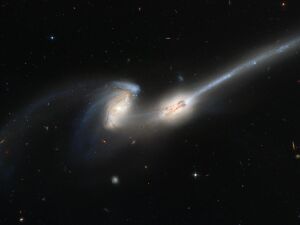Astronomy:Mice Galaxies
| NGC 4676A / 4676B | |
|---|---|
 The Mice Galaxies, NGC 4676A (right) / NGC 4676B (left) | |
| Observation data (J2000 epoch) | |
| Constellation | Coma Berenices |
| Right ascension | 12h 46m 10.1s / 12h 46m 11.2s[1] |
| Declination | +30° 43′ 55″ / +30° 43′ 22″[1] |
| Redshift | 6613 ± 8 / 6607 ± 7 km/s[1] |
| Distance | 290 Mly (89 Mpc)[2] |
| Apparent magnitude (V) | 14.7 / 14.4[1] |
| Characteristics | |
| Type | Irr / SB(s)0/a pec[1] |
| Size | 760,000 ly (233 kpc) (estimated)[lower-alpha 1] |
| Apparent size (V) | 2′.3 × 0′.7 / 2′.2 × 0′.8[1] |
| Notable features | Interacting galaxies |
| Other designations | |
| Mice Galaxies,[1] IC 819 / 820,[1] UGC 7938 / 7939,[1]
PGC 43062 / 43065,[1] Arp 242[1] | |
NGC 4676, or the Mice Galaxies, are two spiral galaxies in the constellation Coma Berenices. About 290 million light-years distant,[2] they have begun the process of colliding and merging. Their "mice" name refers to the long tails produced by tidal action—the relative difference between gravitational pulls on the near and far parts of each galaxy—known here as a galactic tide. It is a possibility that both galaxies, which are members of the Coma Cluster,[3] have experienced collision, and will continue colliding until they coalesce.
The colors of the galaxies are peculiar. In NGC 4676A a core with some dark markings is surrounded by a bluish white remnant of spiral arms. The tail is unusual, starting out blue and terminating in a more yellowish color, despite the fact that the beginning of each arm in virtually every spiral galaxy starts yellow and terminates in a bluish color.[citation needed][clarification needed] NGC 4676B has a yellowish core and two arcs; arm remnants underneath are bluish as well.
The galaxies were photographed in 2002 by the Hubble Space Telescope.[4] In the background of the Mice Galaxies, there are at least 3,300 galaxies, at distances up to 13 billion light-years.
See also
References
- ↑ 1.00 1.01 1.02 1.03 1.04 1.05 1.06 1.07 1.08 1.09 1.10 "NASA/IPAC Extragalactic Database". Results for NGC 4676A / 4676B. http://nedwww.ipac.caltech.edu/.
- ↑ 2.0 2.1 Chien, Li-Hsin; Barnes, Joshua E.; Kewley, Lisa J.; Chambers, Kenneth, C. (May 2007). "Multiobject Spectroscopy of Young Star Clusters in NGC 4676". The Astrophysical Journal 660 (2): L105–L108. doi:10.1086/518215. Bibcode: 2007ApJ...660L.105C.
- ↑ Burbidge, E. M.; Burbidge, G. R. (March 1961). "NGC 4676, a Peculiar System in the Coma Cluster of Galaxies." (in en). The Astrophysical Journal 133: 726. doi:10.1086/147076. ISSN 0004-637X. Bibcode: 1961ApJ...133..726B.
- ↑ "Hubble's New Camera Delivers Breathtaking Views of the Universe". HubbleSite. 2002-04-30. http://hubblesite.org/newscenter/archive/releases/2002/11/image/d.
Notes
- ↑ The size of NGC 4676 A is 194,000 ly, while that of NGC 4676 B is 186,000 ly. This would give 380,000 ly by combining their sizes although the tail is about two times larger, giving 760,000 ly.
External links
Coordinates: ![]() 12h 46m 10.1s, +30° 43′ 55″
12h 46m 10.1s, +30° 43′ 55″
 |

